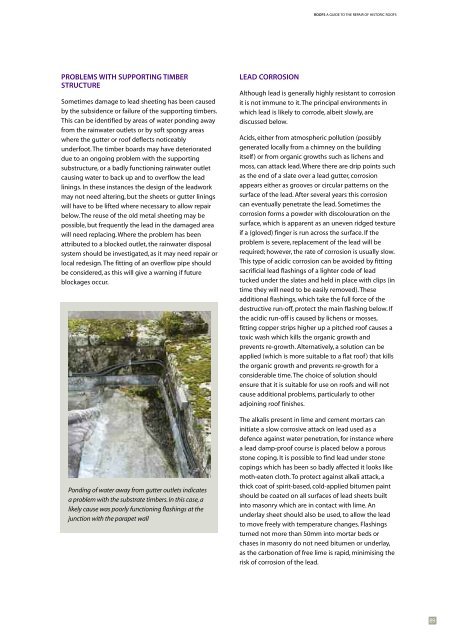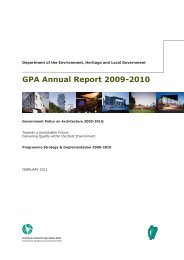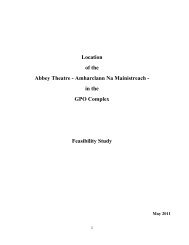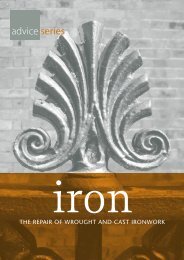A Guide to the Repair of Historic Roofs - Dublin City Council
A Guide to the Repair of Historic Roofs - Dublin City Council
A Guide to the Repair of Historic Roofs - Dublin City Council
Create successful ePaper yourself
Turn your PDF publications into a flip-book with our unique Google optimized e-Paper software.
ROOFS A GUIDE TO THE REPAIR OF HISTORIC ROOFSPROBLEMS WITH SUPPORTING TIMBERSTRUCTURESometimes damage <strong>to</strong> lead sheeting has been causedby <strong>the</strong> subsidence or failure <strong>of</strong> <strong>the</strong> supporting timbers.This can be identified by areas <strong>of</strong> water ponding awayfrom <strong>the</strong> rainwater outlets or by s<strong>of</strong>t spongy areaswhere <strong>the</strong> gutter or ro<strong>of</strong> deflects noticeablyunderfoot. The timber boards may have deteriorateddue <strong>to</strong> an ongoing problem with <strong>the</strong> supportingsubstructure, or a badly functioning rainwater outletcausing water <strong>to</strong> back up and <strong>to</strong> overflow <strong>the</strong> leadlinings. In <strong>the</strong>se instances <strong>the</strong> design <strong>of</strong> <strong>the</strong> leadworkmay not need altering, but <strong>the</strong> sheets or gutter liningswill have <strong>to</strong> be lifted where necessary <strong>to</strong> allow repairbelow. The reuse <strong>of</strong> <strong>the</strong> old metal sheeting may bepossible, but frequently <strong>the</strong> lead in <strong>the</strong> damaged areawill need replacing. Where <strong>the</strong> problem has beenattributed <strong>to</strong> a blocked outlet, <strong>the</strong> rainwater disposalsystem should be investigated, as it may need repair orlocal redesign. The fitting <strong>of</strong> an overflow pipe shouldbe considered, as this will give a warning if futureblockages occur.Ponding <strong>of</strong> water away from gutter outlets indicatesa problem with <strong>the</strong> substrate timbers. In this case, alikely cause was poorly functioning flashings at <strong>the</strong>junction with <strong>the</strong> parapet wallLEAD CORROSIONAlthough lead is generally highly resistant <strong>to</strong> corrosionit is not immune <strong>to</strong> it. The principal environments inwhich lead is likely <strong>to</strong> corrode, albeit slowly, arediscussed below.Acids, ei<strong>the</strong>r from atmospheric pollution (possiblygenerated locally from a chimney on <strong>the</strong> buildingitself ) or from organic growths such as lichens andmoss, can attack lead. Where <strong>the</strong>re are drip points suchas <strong>the</strong> end <strong>of</strong> a slate over a lead gutter, corrosionappears ei<strong>the</strong>r as grooves or circular patterns on <strong>the</strong>surface <strong>of</strong> <strong>the</strong> lead. After several years this corrosioncan eventually penetrate <strong>the</strong> lead. Sometimes <strong>the</strong>corrosion forms a powder with discolouration on <strong>the</strong>surface, which is apparent as an uneven ridged textureif a (gloved) finger is run across <strong>the</strong> surface. If <strong>the</strong>problem is severe, replacement <strong>of</strong> <strong>the</strong> lead will berequired; however, <strong>the</strong> rate <strong>of</strong> corrosion is usually slow.This type <strong>of</strong> acidic corrosion can be avoided by fittingsacrificial lead flashings <strong>of</strong> a lighter code <strong>of</strong> leadtucked under <strong>the</strong> slates and held in place with clips (intime <strong>the</strong>y will need <strong>to</strong> be easily removed). Theseadditional flashings, which take <strong>the</strong> full force <strong>of</strong> <strong>the</strong>destructive run-<strong>of</strong>f, protect <strong>the</strong> main flashing below. If<strong>the</strong> acidic run-<strong>of</strong>f is caused by lichens or mosses,fitting copper strips higher up a pitched ro<strong>of</strong> causes a<strong>to</strong>xic wash which kills <strong>the</strong> organic growth andprevents re-growth. Alternatively, a solution can beapplied (which is more suitable <strong>to</strong> a flat ro<strong>of</strong> ) that kills<strong>the</strong> organic growth and prevents re-growth for aconsiderable time. The choice <strong>of</strong> solution shouldensure that it is suitable for use on ro<strong>of</strong>s and will notcause additional problems, particularly <strong>to</strong> o<strong>the</strong>radjoining ro<strong>of</strong> finishes.The alkalis present in lime and cement mortars caninitiate a slow corrosive attack on lead used as adefence against water penetration, for instance wherea lead damp-pro<strong>of</strong> course is placed below a porouss<strong>to</strong>ne coping. It is possible <strong>to</strong> find lead under s<strong>to</strong>necopings which has been so badly affected it looks likemoth-eaten cloth. To protect against alkali attack, athick coat <strong>of</strong> spirit-based, cold-applied bitumen paintshould be coated on all surfaces <strong>of</strong> lead sheets builtin<strong>to</strong> masonry which are in contact with lime. Anunderlay sheet should also be used, <strong>to</strong> allow <strong>the</strong> lead<strong>to</strong> move freely with temperature changes. Flashingsturned not more than 50mm in<strong>to</strong> mortar beds orchases in masonry do not need bitumen or underlay,as <strong>the</strong> carbonation <strong>of</strong> free lime is rapid, minimising <strong>the</strong>risk <strong>of</strong> corrosion <strong>of</strong> <strong>the</strong> lead.89
















